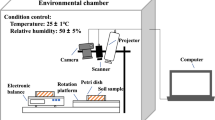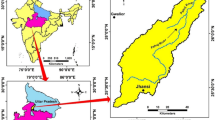Abstract
The structural features of soil in debris flow-triggering region play an important role in the formation and evolution of debris flow. In this paper, a case study on the fractal of soil particle-size distribution (PSDFs) and pore-solid (PSFs) in Jiangjia Ravine was conducted. The results revealed that the soil in Jiangjia Ravine had significant fractal features and its PSDF and PSF had the same variation trend despite different type of soils in debris flow-triggering region: residual soil (RS)>debris flow deposit (DFD)>clinosol (CL), their fractal dimension of PSDFs are respectively between 2.62 and 2.96, 2.52 and 2.68, 2.37 and 2.52; and the fractal dimension of PSFs are respectively between 2.75 and 2.95, 2.57 and 2.72, 2.59 and 2.64. The fractal dimension of soil reflected its complexity as a self-organizing system and was closely related to the evolution of soil in debris flow- triggering region.
Similar content being viewed by others
References
Wang Suna, Lu jun. Fractal and Its Application in Soil Science [J].Chinese Journal of Soil Science, 2005,36(2):249–252 (Ch).
Tyler S W, Wheatcraft S W. Fractal Scaling of Soil Particle Size Distributions: Analysis and Limitations [J].Soil Sci Am J, 1992,56:362–369.
Yang Peiling, Luo Yuanpei, Shi Yuanchun. Soil Fractal Character Token by Particle-Mass Distribution [J].Sci Bulletin J, 1993,38(20):1896–1899 (Ch).
Castrignano A, Stelluti M. Fractal Geometry and Geostatistics for Describing the Field Variability of Soil Aggregation [J].J Agric Engng Res, 1999,73:13–18.
Tyler S W, Wheatcraft S W. Application of Fractal Mathematics to Soil Water Retention Estimation [J].Soil Sci Am J, 1989,53:987–996.
Chen Ningsheng, Zhang Jun. The Research of Permeability on Lose Gravelly Soil in Debris Flow Original Area [J].Journal of Mountain Science, 2001,19(1):169–171.
Yi Shunmin. The Fractal Structure Features of Accumulation in Debris Flow [J].Journal of Natural Disasters, 1994,3(2):91–96.
Li Yong, Chen Xiaoqing, Hu Kaiheng,et al. Fractality of Grain Composition of Debris Flow [J].Acta Geographica Sinica, 2005,60(3):49545.
Zhang Xinbao, Wang YangChun, Li Shaolong,et al. A Study on Soil Erosion and Sediment Sources of Debris Flow Using Caesium-137 Technique in Jiangjia Ravine [J].Soil and Water Conservation in china, 1992,2:28–31 (Ch).
Feng Zili, Cui Peng, Chen Xiaoqing,et al. Observation and Research on Gravitational Erosion Process of Bank Slopes in Headstream Area of Jiangjia Ravine, Yunnan, China [J].Wuhan University Journal of Natural Sciences, 2005,10 (14):713–720.
Wu Jishan, Kang Zhicheng, Tian Lianquan,et al. Debris Flows Observation and Research at Jiangjia Ravine of Yunnan Province [M]. Beijing: Science Press of China, 1990, 29–31 (Ch).
Nanjing Institute of Soil Science, Chinese Academy of Sciences.Physical and Chemic Analysis of Soil [M]. Shanghai: Science Technology Press, 1978 (Ch).
Zhang Baohua.Soil structural and Water Properties and Its Eco-environmental Effects under Different Forests in Typical Regions of Upper Reaches of Yangtze River [D]. Chengdu: Institute of Mountain Hazards and Environment, Chinese Academy of Sciences, 2004: 19–22 (Ch).
Yi Shumin, Tang Huiming. Fractal Structure Features of Granulometric Composition in Frozen Soil and Its Significance [J].Journal of Glaciology and Geocryology, 1994,16(4): 314–320 (Ch).
Feder J.Fractals [M]. New York: Plenum Press, 1988.
Turcotte D L.Fractals and Chaos in Geology and Geophysics [M]. Cambridge: Cambridge University Press. 1992.
Huang Guanhua, Zhan Weihua. Fractal Property of Soil Particle Size Distribution and Its Application [J].Acta Pedologica Sinica, 2002,39(4): 490–497 (Ch).
Huang Guanhua, Zhan Weihua. Modeling Soil Water Retention Curve with Fractal Theory [J].Advances in Water Science, 2002,13(1): 54–59 (Ch).
Wang Xiaodan, Liu Shuzhen, Liu Gangcai. Fractal Characteristics of Soil under Different Land-Use Patterns in the Arid and Semi-Arid Region of the Western Tibet Plateau, China [J].Wuhan University Journal of Natural Sciences, 2005,10(4): 785–790.
Liu Yusong, Zhang Jiwen. Fractal Approach to Measuring Soil Porosity [J].Journal of Southeast University, 1997,27 (3): 127–130 (Ch).
Liu Yusong. Discussion on Fractal Structure of Clay Soil Particle Size Distribution [J].Geotechnical Investigation & Surveying, 1992,19(2): 1–4 (Ch).
Author information
Authors and Affiliations
Corresponding author
Additional information
Foundation item: Supported by the National Science Fund for Distinguished Young Schobars of China (40025103)
Biography: LIAO Chaolin (1975-), male, Ph. D. candidate, research direction: soil erosion and environment.
Rights and permissions
About this article
Cite this article
Chaolin, L., Yurong, H. Fractal characteristic of soil in typical debris flow-triggering region: A case study in Jiangjia Ravine of Dongchuan, Yunnan. Wuhan Univ. J. Nat. Sci. 11, 859–864 (2006). https://doi.org/10.1007/BF02830177
Received:
Issue Date:
DOI: https://doi.org/10.1007/BF02830177




